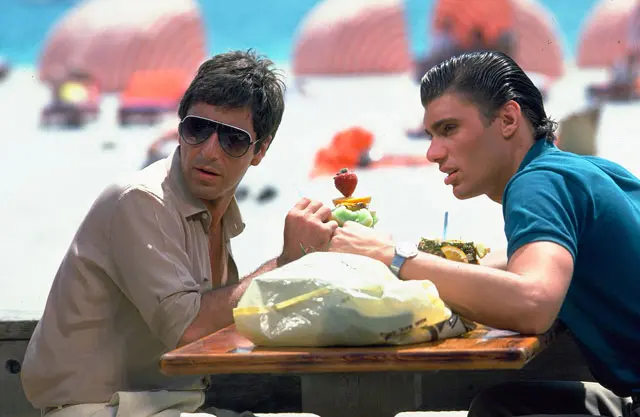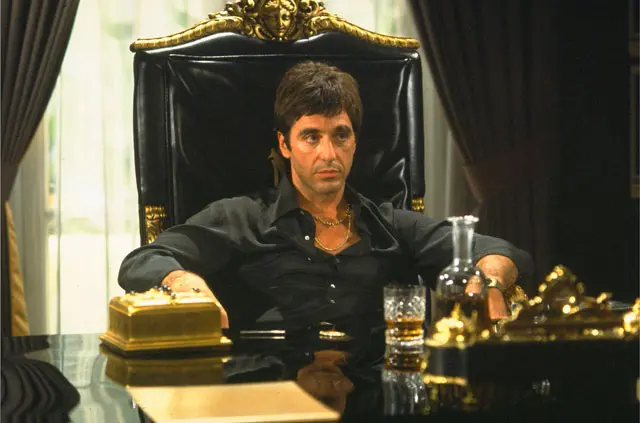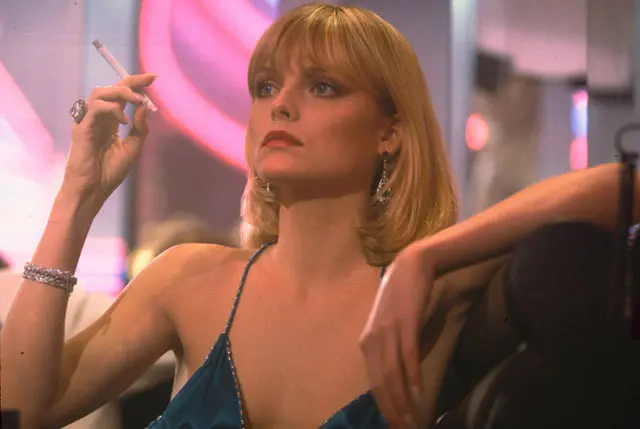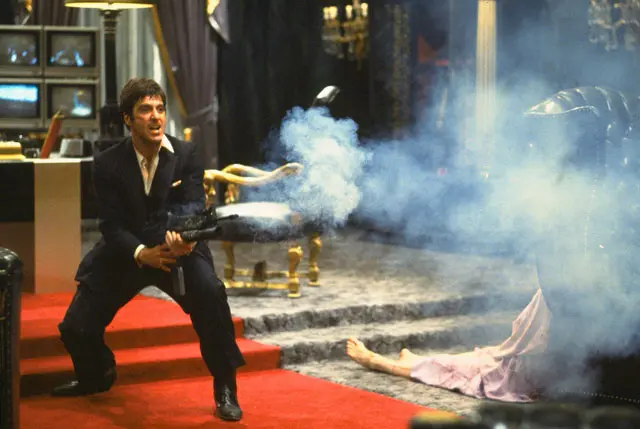 Scarface is a movie that has a huge following, which is a testament to its ability to withstand the test of time.
Scarface is a movie that has a huge following, which is a testament to its ability to withstand the test of time.
And that’s almost the only nice thing I can say about this movie.
I know that I can probably be legally crucified just for saying this, but I really don’t like Scarface. To gain a little perspective on that last sentence, take a few seconds and see if you can think of any American males under the age of 30 you know that don’t like Scarface.
Short list, isn’t it?
I can’t help it. When I was younger I was the kind of kid who said he didn’t like Scarface (or any other popular film) just because everyone else did watch it.
Years later, when I decided to stop being a movie snob, I gave director Brian De Palma’s Scarface another chance. And again it disappointed me.
Then I gave the Scarface Limited Edition SteelBook Blu-ray a chance. And, yet again, the movie itself has disappointed me. However, the Blu-ray presentation lives up to all the expectations of the high definition format.
But it can’t save the fact that this film (in my eyes, at least) is a miserable failure of a motion picture.

Scarface tells the story of Tony Montana, a Cuban street hustler who makes his way to the states and works his way up from low-level mob grunt to the king of a massive cocaine empire. It’s a rags-to-riches-to-grave story about a man who begins with nothing, becomes one of the most powerful and wealthiest men in America, and squanders everything in pursuit of more.
My problem (rather, one of my problems) with Scarface is that it’s gratuitous excess for the sake of gratuitous excess.
One of Tony’s earliest assignments in the world of organized crime goes south and results in a gruesome murder by chainsaw. And even though the victim himself is not shown during the murder, the amount of blood and screaming and gurgling is more excessive than what you might find in the goriest of horror flicks.
Granted, it’s all suggested. It’s also the proverbial sound and fury signifying nothing. There is no emotional or narrative growth birthed from this scene. Not a single character involved learns a single thing from having been a part of it.
At the same time, though, that’s part of the movie’s point: More isn’t always better. Tony quickly amasses a fortune, and despite his ornate mansion or that iconic mountain of coke on his desk, he has nothing. If there is a message to be found in Scarface, it concerns the state of America at the time in which it was filmed.
The 80s were a time when greed was king and too much was ever enough. But there’s absolutely no subtlety to its presentation. When you look at Tony’s mansion in the last act of the movie, you don’t think about the emptiness of his excess. It’s so full that it causes the viewer to become empty. It elicits no response. It’s simply there.
And even praising Scarface as a commentary on 80s decadence seems pointless since Wall Street (still the best of writer Oliver Stone’s babies) did it better a couple years later. Hell, American Psycho did it better nearly 20 years later.
The biggest problem with Scarface is that its title character has no redeemable qualities. The story of Tony Montana (Al Pacino in one of his many defining performances) is the story of an unlikable man who knowingly makes horrible choices. It’s impossible to sympathize with him, and it’s even more of a stretch to relate to him.
In fact, there are hardly any characters in the film who even consider that they might be making a poor choice. Every player in this story knows that their life is leading to ruin, and they are all given countless opportunities to turn it all around. They simply don’t.

And that isn’t to say that I’m some kind of conservative wack job bemoaning film’s glorification of crime and violence.
It’s just that in any story, you must be able to feel something for or at least about the people in the story. I feel nothing for these characters, and if I feel nothing for the people who make up the foundation of the movie then I can feel nothing for the movie itself.
Except profound dislike.
In examination of the performances in the film, there’s not much to say. Pacino’s portrayal of Montana has been dissected to death. There’s very little left to say about it, except that his Cuban accent might be the worst fake accent any actor has ever put on anywhere ever.
Michelle Pfieffer plays Elvira, Tony’s love-interest-turned-wife, so flatly that even her most enraged outbursts are barely noticeable.
And please, whatever you do, don’t get me started on Robert Loggia playing a Hispanic drug lord. I can think of maybe five people on this planet who are less Hispanic than Robert Loggia, and that’s only if I count myself twice.
On the bright side, Steven Bauer makes an inspired effort as Manny, Tony’s No. 2 man. Of everyone in the film, he seems to be the only character with a head on his shoulders that says, “Maybe we should scale this back a bit.” But, just like whatever message this film might have been trying to convey, his is a voice that simply gets drowned out by the noise.
The best performance in the movie belongs to F. Murray Abraham who plays Omar Suarez, one of the underworld figures that stand in the way of Tony’s march to the top. Abraham shines above the rest of the cast because he brings everything that the rest of the cast forgot at home: subtlety and life.
He’s dangerous without going over-the-top, and he exudes cool and panic whenever his scenes call for either. He’s the only true balance in an over-produced mess of a film.
And that brings us to the architects of this cinematic travesty that somehow has become regarded as a classic.
Brian De Palma is a brilliant director. Frankly, he’s a brilliant enough director to have been able to take the unintelligible drivel that was the screenplay for Scarface and turn it into something worthwhile without changing a word.
Instead, every shot is phoned in. Hell, the extras (which we’ll discuss shortly) reveal that Steven Spielberg practically blocked out the climactic showdown in Tony’s mansion and that Stone was instrumental in much of the movie’s making.
In fact, based on the film, De Palma simply wasn’t all that interested in Scarface. Can’t say I blame him.

High-Def Presentation
Universal’s VC-1 1080p transfer for Scarface is okay, but it’s nothing great. Scenes shot in darkness suffer from a horrendous lack of detail, but those shots that are well-lit showcase everything that’s great about Blu-ray. Tony Montana might inhabit a world that’s dark and empty in soul, but it’s rich and colorful in texture, and the Blu-ray treatment brings every color and every fabric to vibrant life. Skin tones often tend to be hit-and-miss for older releases, but they come across pretty-lifelike in the case of Scarface.
The sound mix, however, is a thing of beauty. Universal pulled out all the stops for Scarface, presenting the film with a 7.1 DTS-HD Master Audio track that is absolutely magnificent. Not once is a line of dialogue obscured, even when it’s shouted over gunfire or the nonsensical firing of a grenade launcher. It’s clear that there have been no at-the-source alterations to the sound. It hasn’t been tampered with to work for a 2011 audience; it’s simply been tweaked and made a billion times better. Truly remarkable stuff.
Beyond the Feature
Scarface is accompanied by a plethora of special features, many of which appeared on the film’s last DVD release, but there are a couple of Blu-ray exclusives.
Scarface (1932, 93 minutes) – This is perhaps the best special feature to ever accompany a bad movie: A good movie. Universal includes the original 1932 Howard Hawks production of Scarface. It’s essentially the same story, but it’s treated with just a tiny measure of humanity that could have made all the difference for Stone and De Palma’s version.
U-Control: Picture in Picture Experience – The cast and crew discuss a wide range of topics from the film’s enduring appeal to how it’s viewed by the Cuban community.
U-Control: Scarface Scorecard – This feature gives a running count of each utterance of the F-word as well as a tally of every bullet that’s fired during the film. I assure you, it isn’t worth your time.
The Scarface Phenomenon (39 minutes) – This HD documentary takes a look at what has made Scarface appeal to audiences for nearly 30 years. It’s a 3-part doc that examines how the film was panned (go figure) upon its initial release and how it rose to become a cultural phenomenon.
The World of Tony Montana (12 minutes) – A handful of writers, journalists, and critics discuss their own views on what has enabled Scarface to endure for as long as it has.
The Creating (30 minutes) – De Palma, Stone, and others integral to the production of the film talk about its genesis and the steps required to bring Tony Montana’s story to life.
The Rebirth (10 minutes) – An examination of the inspiration for this film, the original 1932 Scarface as well as a look at the challenges of adapting the Hawks version over 50 years later.

The Acting (15 minutes) – A look at the performances in the film. This featurette pays particular attention to Pacino building his portrayal of Tony from the ground up. All-in-all, it’s an interesting look at how actors (at least try to) bring characters to life.
Scarface: The TV Version (3 minutes) – A few minutes from the heavily-edited-for-broadcast version of the film. This actually manages to elicit a few laughs. Part of me wishes they’d release the TV version on its own.
The Making of Scarface: The World Is Yours (12 minutes) – A brief look at the making of the 2006 video game. If memory serves, playing the game is almost as torturous an experience as watching the movie. And it takes longer to finish…
Note: The only special feature presented in high-definition is The Scarface Phenomenon. The rest are SD reissues of features from the DVD release.
Scarface is beloved by a lot of people. And I’m by no means saying that’s wrong. Different tastes of different audiences is what fuels film and, frankly, all of art.
Maybe I’m just too critical. Maybe I just don’t know how to sit back and enjoy a movie.
But I find it hard – impossible even – to enjoy Scarface. It has no soul. It has no meaning. It just exists.
It’s been 28 years since this film was released and, to its credit, it’s endured. Although when you’re that loud, obnoxious, and desperate for attention, it’s difficult to be ignored.
Shop for Scarface Limited Edition on Blu-ray at a discounted price at Amazon.com.


